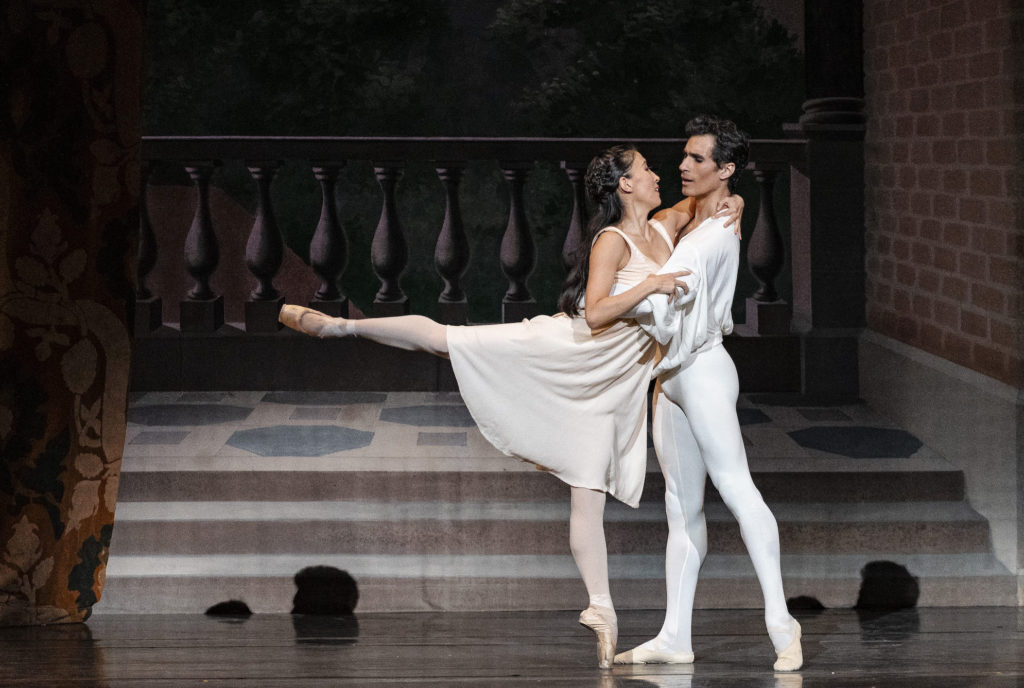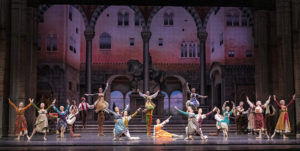Grand Rapids’ Romeo & Juliet: James Sofranko’s first full-length story ballet - Vancouver Ballet Society
- Home
- Reviews 2020 - 2023
- Grand Rapids’ Romeo & Juliet: James Sofranko’s first full-length story ballet

By Steve Sucato
The crown jewel in Grand Rapids Ballet’s 50th anniversary season, artistic director James Sofranko’s Romeo and Juliet, was decidedly a traditional classical ballet take on Shakespeare’s famous tale. The three-act production plus epilogue, the first full-length story ballet the former San Francisco Ballet soloist has choreographed, premiered on February 17 at home in Grand Rapids, Michigan, in the DeVos Performance Hall.
The production, by Michigan’s only full-time professional ballet company, was indicative of the 24-member company’s repertoire of story ballet classics, neo-classical works (including Balanchine), and contemporary ballet from a range of dancemakers (including resident choreographer Penny Saunders).

Set to Sergei Prokofiev’s iconic score, performed with feeling by the Grand Rapids Symphony, the production featured Renaissance costumes and set design by French-born, New York State-based Alain Vaës, with large, detailed painted backdrops that gave a sense of three-dimensional depth to the stage. These were courtesy of Ballet Arizona from an original Boston Ballet production.
Act I opened with brief spotlight tableaux that introduced the Capulet and Montague patriarchs and matriarchs, along with Romeo and Juliet. A bustling scene set in Verona’s public piazza followed, showcasing Sofranko’s Three Muskateer-like take on the relationship between Romeo (Josué Justiz), who favours matters of the heart, and his two sidekicks, Mercutio (Julian Gan) and Benvolio (Nathan Young), who favour making mischief among the villagers. These include a pair of equally boisterous “harlots” wonderfully portrayed by Emily Reed and Alexandra Meister-Upleger. The scene was an early indicator of Sofranko’s briskly paced, straightforward choreography in service of the ballet’s storyline and emotional arcs.
The scene’s merriment was soon interrupted by the arrival of a rather sinister looking Tybalt (Branden Reiners) and his entourage, along with Lord Capulet (Jon Upleger) and Lord Montague (Ednis Gomez), igniting an action-packed street brawl, complete with swords, between the two feuding families. Choreographed by Joe Sofranko, a Los Angeles-based actor and fight choreographer (and the director’s brother), the clash of steel, with dancers lunging and leaping about the stage with seeming abandon, was the most realistic swordplay I have seen in a ballet production.

With nonchalant cockiness and impeccable comedic timing in his taunting of Tybalt, Gan as Mercutio captured the lion’s share of attention in almost every scene he was in. The Malaysian Gan (who won gold at the 2014 Asian Grand Prix International Ballet Competition) is in his second season with the company, where his adroit technical dancing and captivating stage presence will doubtless bring him stardom.
To some of the best known and most dramatic of Prokofiev’s music for the ballet, the Capulet’s masked ball featured Sofranko’s detailed and nuanced choreography in Romeo and Juliet’s first fateful encounter. Justiz as Romeo wove his way through the crowd of guests and across the ballroom as if following the call of a siren, to land squarely in front of Juliet, portrayed with youthful wonder by Yuka Oba-Muschiana, in a love-at-first-sight moment. Both veteran stars of Grand Rapids Ballet, the pair brought refined technique, grace, and acting skills to their captivating performances.
Later, the two engaged in a back-and-forth courtship pas de deux that was full of the joy of discovering love. Those feelings would carry over into the Act I closing balcony scene, where Juliet, with arms outstretched as if pleading to the universe to deliver Romeo to her, had those prayers answered. In the starlight of the Capulet’s garden, their impassioned pas de deux was infused with whirling spins and intricate lifts that showcased Oba-Muschiana and Justiz’s onstage chemistry.

Act II was highlighted by the tragic street fight that leads to the deaths of Mercutio and Tybalt. Here, Sarah Marley as Lady Capulet delivered the ballet’s most over-the-top performance, vacillating between wailing over her dead son, Tybalt, with a more West Side Story than Romeo and Juliet vibe, and having to be physically held back from ripping Romeo to shreds.
Sofranko’s most bravura choreography was reserved for Romeo and Juliet’s multiple pas de deux, including Juliet’s bedroom scene, which opened Act III. There, the newlyweds cemented their love in an embrace-filled dance of yearning and desire with daring lifts and unique holds, with much intertwining of bodies.
Where many Romeo and Juliet ballets end on the star-crossed lovers’ suicides, Sofranko chose to mitigate that conclusion with a fitting-for-the-times epilogue showing the rival Capulet and Montague families making peace with one another so that Romeo and Juliet’s deaths would not be in vain.
Well-crafted and detailed in its storytelling, Grand Rapids Ballet’s new Romeo and Juliet should have a cherished place in the company’s repertoire.

